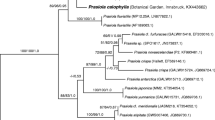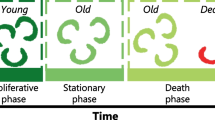Summary
After photosynthesis for two hours in white light (8000 lux), cells of the marine chlorophycean algaAcetabularia mediterranea contain about 80% of the14C incorporated in ethanol soluble form, about 12% in starch, 2–3% in protein, and 6% in the cell wall.
When cells are irradiated with red light (continuous light, 3800 erg · cm−2 · sec−1), the incorporation rate for all four fractions is sharply reduced (Fig. 1). Concomitantly, the14C content in the ethanol soluble fraction rises in three weeks from 80% to about 90%, to the debit of starch and cell wall. In contrast to these findings, incorporation into starch, cell wall, and protein under blue light (continuous light, 5600 erg · cm−2 · sec−1) rises with the irradiation time (Fig. 1).
Starch content per cell rises under red light in spite of declining incorporation rates of14C into starch, whereas it is clearly reduced in blue light below the values for red light cells, notwithstanding the increased14C incorporation rates (Tables 1 and 2). Accumulation of starch under red light seems to be due, therefore, to an inhibition of starch degradation.
Soluble carbohydrate content (fructose, glucose, sucrose, fructosans) stagnates in red light cells and is multiplied in blue light cells (Table 1).
Blue light irradiation after red light pretreatment increases the intensity of photosynthesis. The assimilation rate rises after an irradiation period of eight hours, reaching, after 48 to 72 hours of irradiation, about five to six times the level at the end of the red light period.
Obviously, this rise in the assimilation rate must be preceded by protein synthesis (Fig. 3).14C incorporation into starch and cell wall rises even before the increase in total fixation, too, and, in addition, degradation of starch accumulated during the red light pretreatment is initiated (Table 2). The main amount of14C in the soluble fraction falls to soluble carbohydrates. Irradiation with blue light after red light pretreatment results at first in a reduction of14C incorporation into soluble carbohydrates, followed by a sharp increase till the 72nd hour and another decline (Fig. 4).14C incorporation into fructose, sucrose, and glucose follows this pattern, whereas incorporation into “inulin” increases continuously till the 72nd hour (Fig. 5).
The amount falling to the basic and the acid fractions is small, in contrast.14C incorporation into both fractions rises continuously in blue light (Fig. 4).
Amino acids are formed in the cells even after a three-week period of red light irradiation. Furthermore, the amino acid content is highest at the end of the red light pretreatment (Table 3). Thus, the rate of protein synthesis in red light seems not to be limited by amino acid concentration.
The cause for the reduction of photosynthesis under irradition with red light does not become obvious from the data obtained. Factors possibly playing a role in this process are discussed.
Zusammenfassung
Bei Zellen der marinen Grünalge Acetabularia mediterranea liegen nach 2stündiger Photosynthese im Weißlicht (8000 Lux) etwa 80% des fixierten14C in äthanollöslicher Form vor, etwa 12% entfallen auf Stärke, 2–3% auf Protein und 6% auf die Zellwand.
Werden die Zellen mit Rotlicht (Dauerlicht, 3800 erg · cm−2 · sec−1) bestrahlt, so fällt die Einbaurate in allen 4 Fraktionen stark ab (Abb. 1). Dabei nimmt der14C-Anteil in der äthanollöslichen Fraktion innerhalb von 3 Wochen zu Lasten der Stärke und Zellwand von 80% auf ca. 90% zu. Im Gegensatz dazu wird im Blaulicht (Dauerlicht, 5600 erg · cm−2 · sec−1) mit der Bestrahlungsdauer der Einbau in Stärke, Zellwand und Protein gefördert (Abb. 1).
Trotz sinkender Einbauraten von14C in Stärke nimmt im Rotlicht der Stärkegehalt pro Zelle zu, liegt dagegen im Blaulicht trotz höherer14C-Einbauraten deutlich unter demjenigen der Rotlichtzellen (Tabelle 1 und 2). Die Akkumulation von Stärke im Rotlicht dürfte demnach auf einer Hemmung des Stärkeabbaus beruhen.
Der Gehalt an löslichen Kohlenhydraten (Fructose, Glucose, Saccharose, Fructosane) stagniert in Rotlichtzellen und steigt in Blaulichtzellen um ein Mehrfaches an (Tabelle 1).
Bestrahlung mit Blaulicht nach Rotlichtvorbehandlung führt zu einem Ansteigen der Photosyntheseintensität. Nach 8stündiger Bestrahlung nimmt die Fixierungsrate zu und erreicht nach 48- bis 72stündiger Bestrahlung etwa das 5- bis 6fache des am Ende der Rotlichtbestrahlung gemessenen Wertes (Abb. 2).
Diesem Anstieg der Fixierungsrate muß offenbar eine Synthese von Proteinen vorausgehen (Abb. 3). Auch der14C-Einbau in Stärke und die Zellwand steigt bereits vor der Gesamtfixierung an, und außerdem wird der Abbau der während der Rotlichtvorbehandlung akkumulierten Stärke eingeleitet (Tabelle 2).
Der Hauptanteil des14C in der löslichen Fraktion entfällt auf die löslichen Kohlenhydrate. Bestrahlung mit Blaulicht nach Rotlichtvorbehandlung führt zunächst zu einer Abnahme des14C-Einbaus in die löslichen Kohlenhydrate, gefolgt von einem starken Anstieg bis zur 72. Stunde und einem erneuten Abfall (Abb. 4). Während der14C-Einbau in Fructose, Saccharose und Glucose diesem Kurvenverlauf folgt, steigt der Einbau in „Inulin“ bis zur 72. Stunde kontinuierlich an (Abb. 5).
Demgegenüber ist der auf die basische (Aminosäuren) und die saure Fraktion entfallende Anteil gering. Der14C-Einbau in beide nimmt im Blaulicht kontinuierlich zu (Abb. 4). Aminosäuren werden in den Zellen auch nach 3wöchiger Bestrahlung mit Rotlicht gebildet. Ferner ist der Gehalt an Aminosäuren am Ende der Rotlichtvorbehandlung am höchsten (Tabelle 3). Die Syntheserate von Protein in Rotlicht dürfte demnach nicht durch die Aminosäurekonzentration begrenzt werden.
Die Ursache für den Abfall der Photosyntheseintensität bei Rotlichtbestrahlung ist den vorliegenden Daten nicht zu entnehmen. Die Möglichkeiten, die dabei eine Rolle spielen könnten, werden diskutiert.
Similar content being viewed by others
Literatur
Adler, K., 1967: Spezifische Rolle der Carotinoidabsorption bei der photosynthetischen Sauerstoffentwicklung. Planta (Berl.)75, 220–227.
Awapara, J., 1948: Application of paper chromatography to the estimation of free amino acids in tissues. Arch. Biochem.19, 172–173.
Bidwell, R. G. S., W. B. Levin, andD. C. Shephard, 1969: Photosynthesis, photorespiration, and respiration of chloroplasts fromAcetabularia mediterranea. Plant Physiol.44, 946–954.
Clauss, H., 1963: Ober den Einfluß von Rot- und Blaulicht auf das Wachstum kernhaltiger Teile vonAcetabularia mediterranea. Naturwissenschaften50, 719.
—, 1968: Beeinflussung der Morphogenese, Substanzproduktion und Proteinzunahme vonAcetabularia mediterranea durch sichtbare Strahlung. Protoplasma65, 49–80.
—, 1970: Effect of red and blue light on morphogenesis and metabolism ofAcetabularia mediterranea. In: Biology ofAcetabularia (J. Brachet andS. Bonotto, eds.). New York-London: Academic Press.
—, undK. Keck, 1959: Über die löslichen Kohlenhydrate der GrünalgeAcetabularia mediterranea und deren quantitative Veränderungen in kernhaltigen und kernlosen Teilen. Planta (Berl.)52, 243–253.
Dörfel, H., 1955: Protein und seine Bausteine. In: Papierchromatographie in der Botanik (H. F. Linskens, ed.). Berlin-Göttingen-Heidelberg: Springer-Verlag.
Fondeville, J. C., H. A. Borthwick, andS. B. Hendricks, 1966: Leaflet movement ofMimosa pudica L. indicative of phytochrome action. Planta (Berl.)69, 357–364.
Hämmerling, J., 1963: Nucleo-cytoplasm interaction inAcetabularia and other cells. Ann. Rev. Plant Physiol.14, 65–92.
Hauschild, A. H. W., C. D. Nelson, andG. Krotkov, 1964: Concurrent changes in the products and the rate of photosynthesis inChlorella vulgaris in the presence of blue light. Naturwissenschaften51, 274.
Kowallik, W., 1962: Über die Wirkung des blauen und roten Spektralbereichs auf die Zusammensetzung und Zellteilung synchronisierter Chlorellen. Planta (Berl.)58, 337–365.
—, 1966: Einfluß verschiedener Lichtwellenlängen auf die Zusammensetzung vonChlorella in Glucosekultur bei gehemmter Photosynthese. Planta (Berl.)69, 292–295.
—, 1967: Action spectrum for an enhancement of endogenous respiration by light inChlorella. Plant Physiol.42, 672–676.
—, 1969: Der Einfluß von Licht auf die Atmung vonChlorella bei gehemmter Photosynthese. Planta (Berl.)86, 50–62.
—, andH. Gaffron, 1966: Respiration induced by blue light. Planta (Berl.)69, 92–95.
Laudenbach, B., undA. Pirson, 1969: Uber den Kohlenhydratumsatz inChlorella unter dem Einfluß von blauem und rotem Licht. Arch. Mikrobiol.67, 226–242.
Neal, G. E., andH. Beevers, 1960: Pyruvate utilization in castorbean endosperm and other tissues. Biochem. J.74, 409–416.
Pirson, A., undW. Kowallik, 1960: Wirkung des blauen und roten Spektralbereichs auf die Zusammensetzung vonChlorella bei Anzucht im Licht-Dunkel-Wechsel. Naturwissenschaften47, 476–477.
— —, 1964: Spectral responses to light by unicellular plants. Photobiol.2, 489–497.
Richmond, V., andB. S. Hartley, 1959: A two-dimensional system for the separation of amino-acids and peptides on paper. Nature184, 1869–1870.
Roe, J. H., J. H. Epstein, andN. P. Goldstein, 1949: A photometric method for the determination of inulin in plasma and urine. J. Biol. Chem.178, 839–845.
Schael, U., undH. Clauss, 1968: Die Wirkung von Rotlicht und Blaulicht auf die Photosynthese vonAcetabularia mediterranea. Planta (Berl.)78, 98–114.
Shephard, D. C., 1970: Photosynthesis in chloroplasts isolated fromAcetabularia mediterranea. In: Biology ofAcetabularia (J. Brächet andS. Bonotto, eds.). New York-London: Academic Press.
Terborgh, J. W., 1965: Effect of red and blue light on the growth and morphogenesis ofAcetabularia crenulata. Nature207, 1360–1363.
—, 1966: Potentiation of photosynthetic oxygen evolution in red light by small quantities of monochromatic blue light. Plant Physiol.41, 1401–1410.
Zetsche, K., 1967: Unterschiedliche Zusammensetzung von Stiel- und Hutzellwand beiAcetabularia mediterranea. Planta (Berl.)76, 326–334.
Author information
Authors and Affiliations
Additional information
Die Untersuchungen wurden durch Sachmittel der Deutschen Forschungsgesellschaft unterstützt. Frau I. MAASS danke ich für die sorgfältige Mithilfe bei den Versuchen.
Rights and permissions
About this article
Cite this article
Clauss, H. Der Einfluß von Rot- und Blaulicht auf die Photosynthese vonAcetabularia mediterranea und auf die Verteilung des assimilierten Kohlenstoffs. Protoplasma 74, 357–379 (1972). https://doi.org/10.1007/BF01282538
Received:
Issue Date:
DOI: https://doi.org/10.1007/BF01282538




